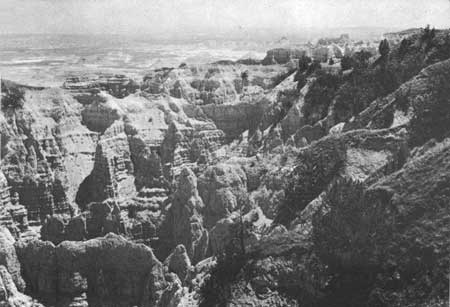|
BADLANDS National Park |
 |
Plants
It is estimated that 60 percent of the monument is nearly barren badlands. The remainder, however, contains the various types of grasses that are found just above the broken wall of the badlands, on isolated buttes extending out from the wall, and on the plain below the wall. In addition, colorful wildflowers dot the land in the early summer. Broad-leaved trees occur sparsely along the stream courses. Small groves of juniper grow in the vicinity of Sheep Mountain and in many of the protected pockets and passes. With their verdant foliage, they relieve the barrenness of the deeply eroded canyons and pinnacles.
 Junipers have become established on the better stabilized slopes |
TREES
The juniper, unlike many other conifers, appears to thrive in all parts of the country and under the most contrasting weather conditions. It withstands the cold of the north and flourishes in the extreme heat of the south. Most of the members of this large genus prefer open, sunny locations and light, clay soils. It is commonly, but incorrectly, called "cedar." It is one of the best-known conifers, for with its wide range of shapes it serves well as an ornament in landscape work.
ROCKY MOUNTAIN JUNIPER. Having an exceedingly wide range, this juniper occurs from Montana to Arizona. In Badlands National Monument and vicinity its height does not exceed 20 to 25 feet. Often it is no higher than a man's head. The foliage has both sharp-pointed, prickly needles and smooth, scalelike ones; sometimes both appear on the same tree. The small, blue, berrylike cone remains on the tree and is a source of food for birds, coyotes, and some other animals during both summer and winter. The foliage and wood have a pungent odor.
PLAINS COTTONWOOD. This is a rapidly growing tree, which matures quickly. It much resembles the eastern cottonwood, with which it was long confused. Often reaching a diameter of 2 or 3 feet, it has a large, spreading top, which gives shade to both man and animal. In early times it was planted by the settler as a shade tree. The leaves are large and oval, with the typical waxy, green gloss of the cottonwood. It grows singly or in small groves in the valleys and along the streambeds. For the beavers that live in the permanent streams of the monument region, cottonwood is the first choice for food and building material.
AMERICAN ELM. The beautiful, vaselike form of the elm is a common sight on the streets of American cities. Along the streams of the badlands, wherever sufficient moisture is available, it grows singly or in small clumps. The leaves are oval, with pointed tips, evenly spaced parallel vein ribs, and finely and evenly serrated edges. This is an important browse tree for deer.
BOXELDER. The fast-growing boxelder was planted extensively as a shade tree by the early pioneers. Though not particularly attractive, it has dense foliage and provides shelter within a few years. It is sometimes called ash-leaved maple, for it is actually a maple with leaves compound (divided) like those of the ash. Boxelder grows along stream courses and in the canyon bottoms.
COMMON CHOKECHERRY. Actually a large shrub, this wild cherry grows in dense thickets in draws and in canyon bottoms. It bears a bright red berry that turns shiny black when ripe. The fruit, which was used by the pioneer housewife, is still the source of delicious jelly and jam. It is a favored food of birds, coyotes, foxes, and some rodents.
SILVER BUFFALOBERRY. This dense, bushy shrub is found growing along the sides of streambeds and nestling in the depressions on the slopes of protected ridges. The long narrow leaves are silver-gray on both surfaces and grow on branches and twigs that bear long, sharp thorns. The red, currant-sized fruit is borne in clusters and is extremely sour. From it a wonderful, tart jelly is made—a favorite of both the pioneer and the modern housewife. It provides an important food for birds.

|

|
|
|
|
Last Modified: Sat, Nov 4 2006 10:00:00 pm PST |


